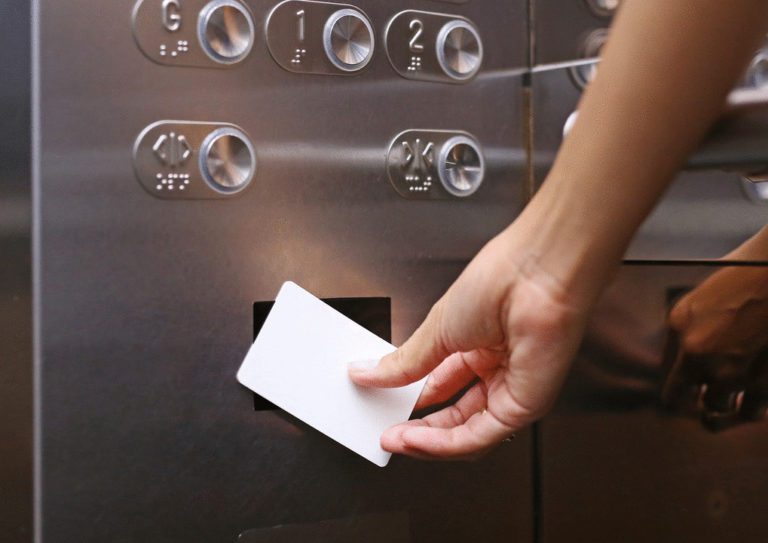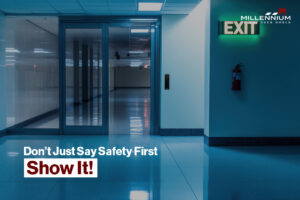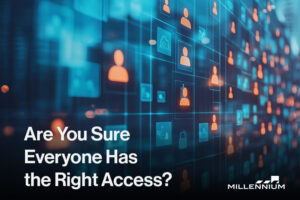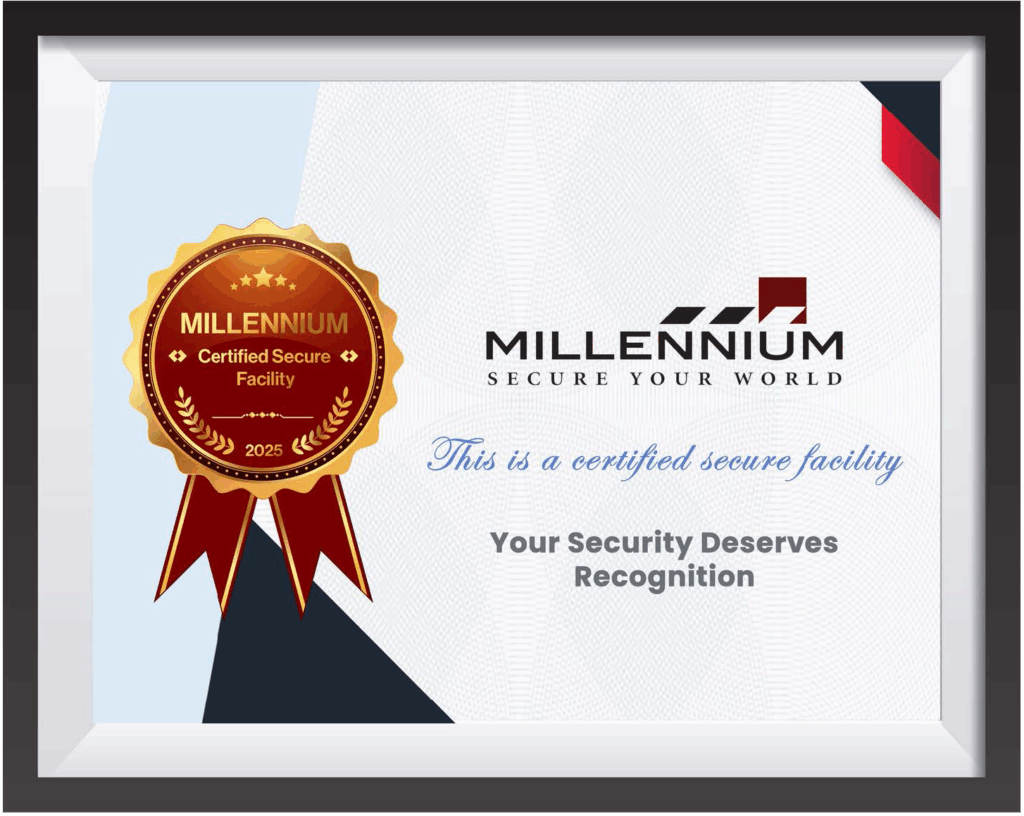In modern building management, elevator access control has become essential to secure and restrict movement within multi-floor facilities. Unlike conventional access control, where authorized users simply open doors, elevator access control directs movement through multiple building levels, limiting floor access to only those permitted.
This guide delves into the mechanics of elevator access control, including how it works, types of systems, credentials, configurations, security challenges, and evolving cloud-based technologies. With this knowledge, building managers and property owners can elevate their security measures to enhance building convenience and safety.
Deciphering the Functionality:
An elevator access control system relies on three main components:
- Elevator Control Buttons: Used to open and close doors, make emergency calls, and select floors.
- Access Readers: These devices, using RFID, keypads, or biometric scanners, verify that users have the proper credentials to access specific floors.
- Access Control Panel: This control hub manages user data and permissions, typically as an on-site server or through a cloud-based solution.
Together, these components ensure that only authorized personnel can access certain floors, promoting security and safety in sensitive areas like office buildings, medical facilities, or high-rise residential complexes.
Streamlined Usage Instructions
Using elevator access control is straightforward. Upon entering the elevator, a user presents their credential—be it a keycard, mobile phone, PIN, biometric scan, or one-time code. If authorized, the system allows the elevator to move to the designated floor. Unauthorized users will be restricted from selecting or accessing restricted floors.
Types of Elevator Access Control Credentials
To accommodate various security needs and user preferences, elevator access systems support different types of credentials:
- Mobile Credentials: Allows users to access floors by tapping a mobile device, reducing the need for physical keys or cards.
- Keycards, Fobs, or Badges: The most common credentials, these provide reliable access when swiped or tapped.
- PIN or Passcode: Ideal for temporary or multi-user access, users enter a code to gain access to specific floors.
- One-Time Code: This credential type is ideal for one-time visitors, such as deliveries, allowing managers to provide a temporary access code that expires after use.
- Biometric Access: Uses unique user data, like fingerprints or facial recognition, to ensure high-security access.
Configurations of Elevator Access Control Systems
Elevator access control can be customized to fit specific building needs. Here are four common configurations:
- Private Elevator for General Access: Users require authorization to summon the elevator but can access any floor freely once inside.
- Public Elevator with Restricted Floor Access: The elevator can be called without restrictions, but access to certain floors requires credentials.
- Private Elevator with Selective Floor Access: Users need authorization both to call the elevator and to access specific floors.
- Destination Control System (DCS): This advanced system allows users to select their destination on an external panel, which optimizes elevator usage based on the scanned credential, directing users to specific elevators.
The Rise of Cloud-Based Elevator Access Control
With remote work and evolving security needs, cloud-based access control systems are gaining popularity. These systems allow remote management and monitoring, making them ideal for multi-location building owners and property managers. They also support seamless updates and scalability, adapting easily as buildings add new floors or tenants.
Popular Cloud-Based Options Include:
- Single Elevator Access Control: A cost-effective solution for small buildings or residences.
- Elevator Banks: Suited for high-rise commercial buildings where multiple elevators serve various floors.
- Smart Elevators: Integrates multiple elevators into a centralized system, ideal for office towers where efficient elevator use is essential.
Expanded Security Enhancements
Modern elevator access control systems offer enhanced features to ensure both convenience and heightened security:
- Time-Based Access Permissions: Limits floor access to specific hours, suitable for facilities with restricted visiting hours.
- User Logging and Reporting: Tracks access attempts and movements, providing insights for security audits.
- Anti-Passback Technology: Ensures credentials can’t be reused immediately, reducing the risk of “tailgating” unauthorized entry.
- Integration with CCTV: Pairs elevator access logs with real-time video, allowing security teams to monitor and respond to potential threats efficiently.

Detailed Challenges and Solutions in Elevator Access Control
Elevator access control faces unique challenges due to frequent public use and the potential for security lapses. Here’s a look at some common issues and solutions:
- Tailgating: One of the most common issues, tailgating involves unauthorized individuals entering behind an authorized user. Anti-tailgating technology and clear user guidelines can help mitigate this risk.
- System Failures: Elevator access systems must remain operational even during power outages or software failures. Back-up power sources and fail-safe protocols can keep elevators running in an emergency, ensuring user safety.
- Credential Security: Lost or stolen credentials, like cards or mobile devices, can compromise security. Multi-factor authentication and biometric credentials offer additional protection by tying access to a user’s unique characteristics.
Technological Advancements in Elevator Access Control
In the ever-evolving landscape of building security, modern elevator access control systems integrate cutting-edge technologies to help overcome common security challenges. Here’s how these systems integrate with other technologies to enhance reliability and security:
- Mobile Access Control Integration: Mobile access control systems enable building managers to remotely grant access to elevators using mobile devices. This capability is especially useful in managing visitor access and responding to emergencies quickly, all without the need for physical presence on-site.
- Video-Based Analytics Integration: Advanced access control systems integrate seamlessly with video surveillance, using video-based analytics to detect unusual behavior patterns near elevators. By analyzing real-time footage, the system can identify potential security threats, alerting personnel to suspicious activities, and allowing for quicker response times. This integration also allows for footage to be linked directly to specific access events, simplifying the process of security review and incident management.
- Tenant Management Module: Access control systems offer robust tenant management features, enabling multi-tenant buildings to customize and streamline access for each tenant. This module ensures that tenants can only access floors or areas relevant to their needs, minimizing security risks and ensuring that authorized personnel have controlled access across different building levels.
- Visitor Management Module: A visitor management module integrated with the access control system allows administrators to provide secure one-time passcodes or time-limited access credentials for visitors. This feature helps track visitor movements from entrance to exit, ensuring that the system keeps records of all access attempts. The collected data is stored in the system’s database, enabling easy access to visitor logs and reports whenever necessary. This level of integration helps improve security while maintaining convenience for authorized visitors.
By integrating these advanced solutions, elevator access control systems are not only more secure but also more efficient, helping building owners and managers maintain better control and streamline their operations.
Safety Considerations in Elevator Access Control
Elevator access control systems play a crucial role in ensuring the safety of individuals within various types of buildings, whether they are residential complexes, hotels, hospitals, corporate offices, or any other facility. These systems go beyond just restricting access—they help create a safer environment for everyone inside the building. Here are key safety features that are vital for building occupants:
- Restricted Access to Sensitive Areas: For facilities like hospitals, corporate offices, or residential buildings, restricting elevator access to sensitive floors is essential for safety. Whether it’s controlling access to emergency rooms, executive offices, or private apartments, access control ensures that only authorized individuals can reach specific areas, preventing unauthorized access to secure spaces.
- Emergency Access: Elevator access control systems can integrate with emergency building plans, allowing for easy access to certain floors during emergencies. For example, in hospitals, it can prioritize access to critical care floors or allow emergency personnel to reach the scene of a crisis quickly.
- Floor-Based Restrictions for High-Risk Areas: In high-traffic or high-risk areas like hospitals, hotels, or corporate facilities, elevator access can be restricted by time or personnel designation. If a certain floor, such as an operating room or restricted office area, requires heightened security, the system can ensure that only those with appropriate clearance are granted access during critical hours.
- Building Occupant Safety and Control: In larger buildings, safety can be further enhanced through integrations that ensure safe movement during after-hours or low-traffic periods. For instance, hotels and residential buildings can use the system to limit access to specific floors at certain times, enhancing safety and preventing unauthorized or dangerous activities.
- Emergency Overrides and Fail-Safes: Elevator access control systems come with fail-safe options that ensure elevators remain operational even during power outages or system malfunctions. This is crucial for maintaining occupant safety, especially in healthcare facilities and high-rise buildings, where quick evacuation might be necessary.
By using these safety-focused features, building managers can ensure that elevator systems not only manage access but also protect building occupants and maintain a safe and secure environment for everyone, regardless of the facility type.
Benefits of Implementing Elevator Access Control
- Enhanced Security: Protects sensitive areas and provides detailed access logs for security auditing.
- Reduced Liability: Access control minimizes the risk of unauthorized access, which is critical for high-stakes facilities like hospitals, corporate offices, and residential buildings.
- Improved Efficiency: Access control systems with destination controls help manage elevator traffic, reducing congestion and wait times for users.
- Scalability: Cloud-based systems and advanced configurations allow building owners to scale access control systems as buildings grow or tenants change.
Conclusion
Elevator access control is a cornerstone of modern building security, enabling managers to control and monitor access to floors with unparalleled precision. By understanding its configurations, types, challenges, and solutions, you can select a system tailored to your building’s unique requirements, ensuring maximum security, efficiency, and user satisfaction. As technology evolves, the future of elevator access control will likely continue to bring even smarter, more responsive solutions to enhance building safety and convenience.
Ready to Enhance Your Building’s Safety?
If you’re looking to improve safety, security, and control within your building, now is the time to explore the benefits of an integrated elevator access control system. Whether it’s for a residential, corporate, healthcare, or hotel setting, we can help you customize a solution that fits your needs.
Get in touch with us today to learn more and secure your building’s future!
Millennium is a scalable, hosted, access control platform that services any type of real estate. Our cloud-based solution allows managers and tenants to efficiently manage their physical security from anywhere while enhancing experience and driving profitability.













